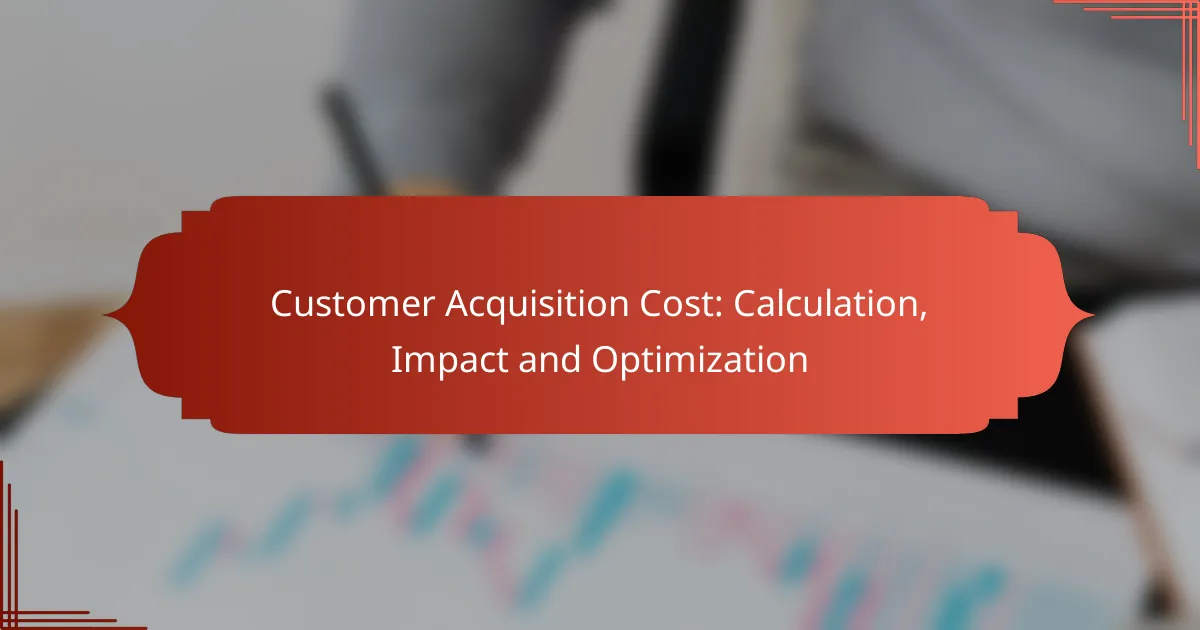Customer Acquisition Cost (CAC) is a vital metric that measures the total expenses incurred in acquiring new customers, providing insights into the effectiveness of marketing and sales strategies. By understanding and optimizing CAC, businesses can enhance their profitability and ensure sustainable growth. Key strategies for improvement include refining marketing approaches, boosting customer retention, and utilizing analytics tools to drive efficiency.
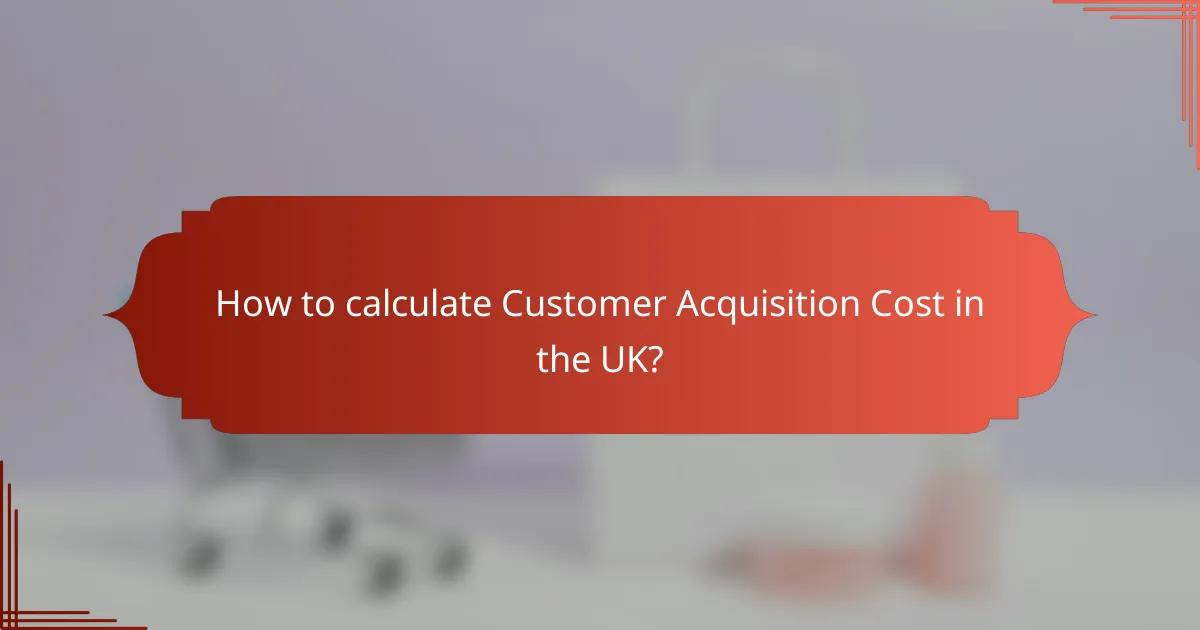
How to calculate Customer Acquisition Cost in the UK?
Customer Acquisition Cost (CAC) in the UK is calculated by dividing the total costs associated with acquiring new customers by the number of customers gained during a specific period. This metric helps businesses understand the efficiency of their marketing and sales efforts in attracting new clients.
Formula for CAC calculation
The formula for calculating Customer Acquisition Cost is straightforward: CAC = Total Marketing and Sales Expenses / Number of New Customers Acquired. This includes all costs related to marketing campaigns, sales team salaries, and any other expenses directly tied to customer acquisition.
To ensure accuracy, consider including both fixed and variable costs in your total expenses. This comprehensive approach provides a clearer picture of your true CAC, allowing for better financial planning.
Examples of CAC calculation
For instance, if a UK-based company spends £10,000 on marketing and sales in a month and acquires 100 new customers, the CAC would be £100 (£10,000 / 100). This figure indicates the average cost incurred to gain each new customer.
Another example could involve a business that invests £5,000 in marketing and brings in 50 new customers. Here, the CAC would be £100 (£5,000 / 50), showing that regardless of the total spend, the cost per customer remains consistent.
Common mistakes in CAC calculation
A frequent mistake in CAC calculation is excluding certain costs, such as overhead or customer support expenses, which can lead to an underestimation of the true cost. Ensure all relevant expenses are accounted for to avoid skewed results.
Another common error is using outdated data or not adjusting for seasonality in customer acquisition. Regularly updating your calculations and considering market fluctuations will provide a more accurate assessment of your CAC over time.
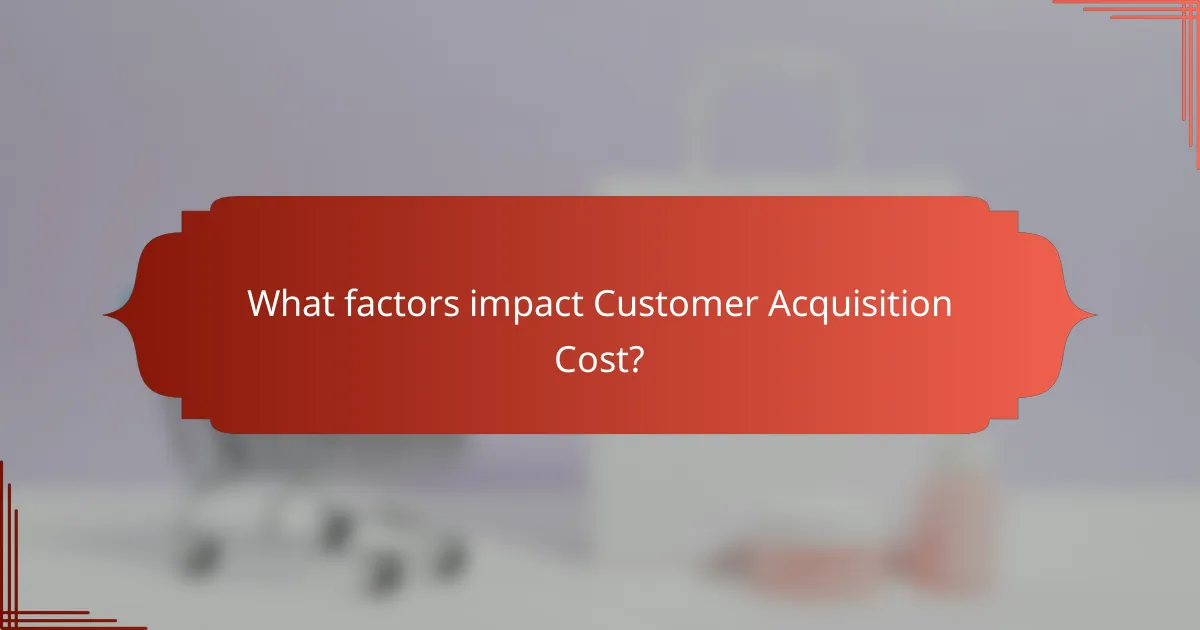
What factors impact Customer Acquisition Cost?
Customer Acquisition Cost (CAC) is influenced by various factors that can significantly affect a company’s marketing and sales expenses. Understanding these factors is crucial for optimizing CAC and improving overall profitability.
Marketing channel efficiency
The efficiency of marketing channels directly impacts CAC. Channels such as social media, email marketing, and paid advertising can vary widely in their effectiveness. For instance, social media may yield lower costs per acquisition compared to traditional advertising methods.
To optimize channel efficiency, regularly analyze the performance of each channel. Focus on metrics like conversion rates and customer engagement to determine which channels provide the best return on investment (ROI). Adjust your budget allocation accordingly to maximize effectiveness.
Sales team performance
The performance of the sales team plays a critical role in determining CAC. A highly skilled sales team can convert leads into customers more effectively, reducing the overall cost of acquisition. Training and motivation are essential to enhance their performance.
Consider implementing performance metrics, such as the number of calls made or meetings scheduled, to track sales team effectiveness. Regular feedback and coaching can help improve these metrics and, in turn, lower CAC.
Target audience characteristics
The characteristics of your target audience significantly influence CAC. Understanding demographics, preferences, and behaviors allows for more tailored marketing strategies that resonate with potential customers. A well-defined target audience can lead to higher conversion rates and lower acquisition costs.
Conduct market research to gather insights about your audience. Utilize this information to create personalized marketing campaigns that address specific needs and pain points, ultimately improving CAC. Avoid broad targeting, as it often leads to wasted resources and higher costs.
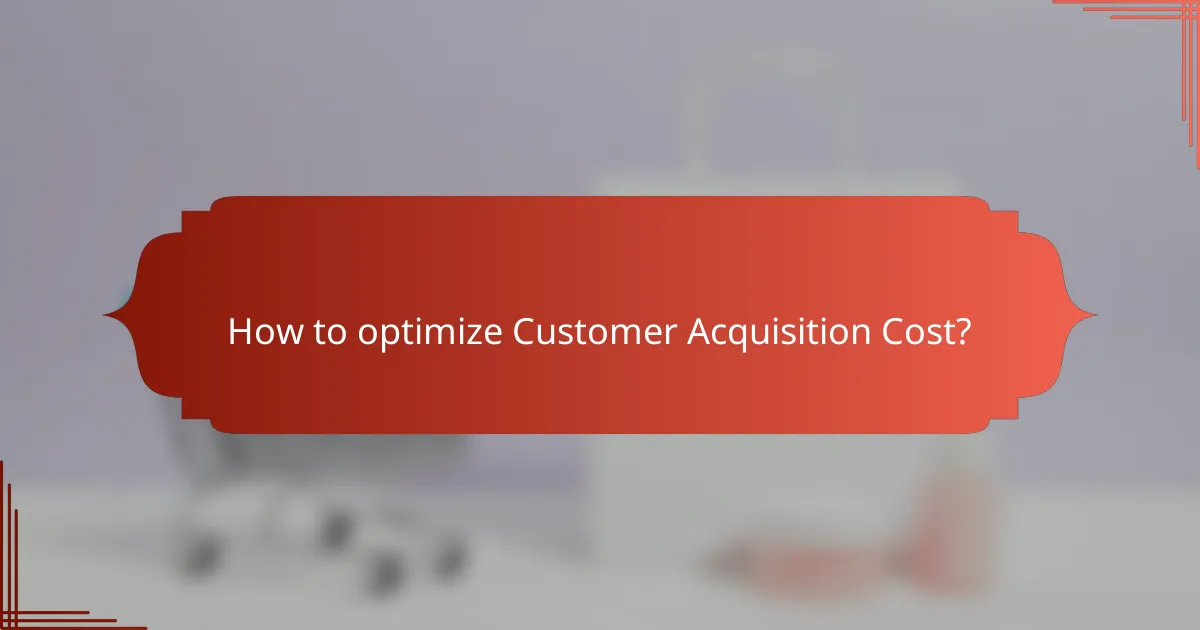
How to optimize Customer Acquisition Cost?
To optimize Customer Acquisition Cost (CAC), businesses should focus on refining their marketing strategies, enhancing customer retention, and leveraging analytics tools. These approaches can help reduce expenses while maximizing the value of each customer acquired.
Improving marketing strategies
Refining marketing strategies is essential for lowering CAC. This can involve targeting specific demographics more effectively, utilizing cost-efficient channels, and creating compelling content that resonates with potential customers. For instance, businesses can shift from traditional advertising to digital platforms, which often yield higher engagement rates at lower costs.
Consider implementing A/B testing to evaluate different marketing messages and channels. This method allows you to identify what works best, enabling you to allocate resources more effectively. Aim for a mix of organic and paid strategies to balance costs and reach.
Enhancing customer retention
Improving customer retention directly impacts CAC by reducing the need for constant new customer acquisition. Satisfied customers are more likely to make repeat purchases and refer others, effectively lowering your overall costs. Focus on providing exceptional customer service and building relationships through personalized communication.
Implement loyalty programs or incentives to encourage repeat business. For example, offering discounts or rewards for referrals can motivate existing customers to promote your brand, further decreasing CAC. Regularly gather feedback to understand customer needs and adjust your offerings accordingly.
Utilizing analytics tools
Analytics tools are vital for tracking and optimizing CAC. By analyzing customer data, businesses can identify trends, measure campaign effectiveness, and make informed decisions. Tools like Google Analytics or CRM software can provide insights into customer behavior and acquisition channels.
Regularly review key performance indicators (KPIs) such as conversion rates and customer lifetime value (CLV). This data helps in understanding which strategies yield the best results and where adjustments are necessary. Avoid relying solely on intuition; data-driven decisions typically lead to better outcomes in optimizing CAC.
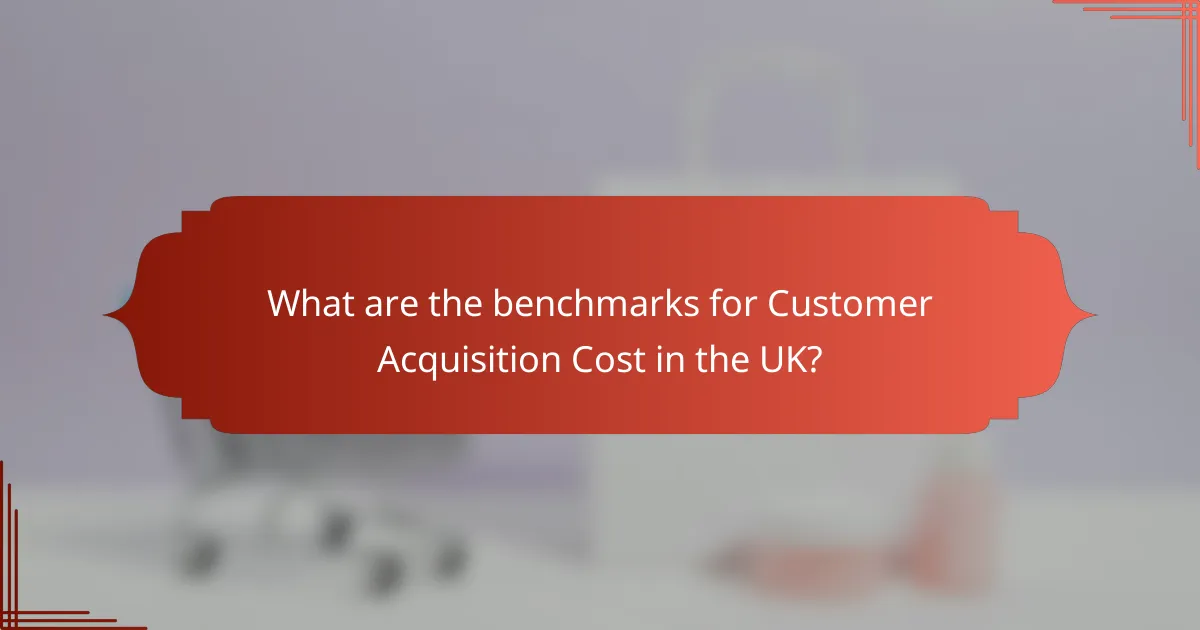
What are the benchmarks for Customer Acquisition Cost in the UK?
In the UK, Customer Acquisition Cost (CAC) benchmarks typically range from £50 to £250, depending on the industry and business model. Understanding these benchmarks helps businesses gauge their marketing efficiency and set realistic acquisition goals.
Industry-specific CAC benchmarks
Different industries exhibit varying CAC benchmarks due to factors like competition and customer lifetime value. For example, e-commerce businesses may see CACs around £70 to £150, while SaaS companies might experience higher costs, ranging from £100 to £300. Knowing your industry’s average can guide budget allocations and marketing strategies.
Additionally, sectors like finance and insurance often report CACs exceeding £200, reflecting the high stakes and regulatory complexities involved. Businesses should continually analyze their CAC against industry standards to identify areas for improvement.
Comparative analysis with competitors
To effectively evaluate your CAC, compare it with competitors in your market. This analysis can reveal whether your acquisition costs are in line with industry norms or if adjustments are necessary. Tools like market research reports and competitor analysis platforms can provide valuable insights.
Consider conducting a SWOT analysis to understand your strengths and weaknesses relative to competitors. If your CAC is significantly higher, explore areas such as marketing channels, messaging, and customer targeting to optimize your acquisition strategy and reduce costs.

How does Customer Acquisition Cost affect business growth?
Customer Acquisition Cost (CAC) directly impacts business growth by determining how much a company spends to acquire each new customer. A high CAC can limit profitability and hinder expansion, while a lower CAC can enhance financial performance and market reach.
Impact on profitability
The relationship between CAC and profitability is crucial. If the cost to acquire customers exceeds the revenue generated from them, businesses face reduced margins. Ideally, companies aim for a CAC that allows for a return on investment within a reasonable timeframe, often targeting a ratio of 3:1, where every dollar spent on acquisition yields three dollars in revenue.
For example, if a business spends $100 to acquire a customer who generates $300 in revenue, it maintains a healthy profit margin. Regularly analyzing CAC helps identify inefficiencies in marketing strategies that could be optimized for better profitability.
Influence on marketing budget
CAC significantly influences how businesses allocate their marketing budgets. A higher CAC may necessitate a reevaluation of marketing strategies, leading to a shift in budget towards more cost-effective channels. For instance, companies might invest more in organic search or referral programs, which typically have lower acquisition costs compared to paid advertising.
Additionally, understanding CAC helps businesses forecast future marketing expenses and set realistic growth targets. By continuously monitoring CAC, companies can adjust their marketing efforts to ensure they remain within budget while still achieving desired customer growth.

What are the prerequisites for effective CAC management?
Effective Customer Acquisition Cost (CAC) management requires a clear understanding of your customer lifetime value and well-defined marketing goals. These elements enable businesses to allocate resources efficiently and optimize their acquisition strategies.
Understanding customer lifetime value
Customer lifetime value (CLV) is the total revenue a business can expect from a single customer throughout their relationship. Knowing your CLV helps in determining how much you can afford to spend on acquiring new customers while still maintaining profitability.
To calculate CLV, consider factors such as average purchase value, purchase frequency, and customer retention rate. For example, if a customer spends $100 per purchase, makes three purchases a year, and stays for five years, the CLV would be $1,500.
Establishing clear marketing goals
Clear marketing goals are essential for effective CAC management as they guide your acquisition strategies. Goals should be specific, measurable, achievable, relevant, and time-bound (SMART), allowing you to track progress and adjust tactics as needed.
For instance, if your goal is to reduce CAC by 20% over the next quarter, you might focus on improving conversion rates or enhancing customer targeting. Regularly reviewing these goals ensures that your marketing efforts align with overall business objectives and adapt to market changes.

What tools can help track Customer Acquisition Cost?
Several tools can effectively track Customer Acquisition Cost (CAC), providing insights into marketing efficiency and customer value. These tools range from analytics platforms to customer relationship management (CRM) systems, each offering unique features to help businesses monitor and optimize their CAC.
Analytics Platforms
Analytics platforms like Google Analytics and Adobe Analytics are essential for tracking CAC. They allow businesses to monitor website traffic, user behavior, and conversion rates, which are critical for calculating CAC. By analyzing these metrics, companies can identify which marketing channels are most effective in acquiring customers.
For example, Google Analytics can help you segment traffic sources, enabling you to see how much you spend on each channel relative to the number of customers acquired. This insight can guide budget allocation and strategy adjustments.
Customer Relationship Management (CRM) Systems
CRM systems such as Salesforce and HubSpot play a vital role in tracking CAC by managing customer interactions and sales data. These tools help businesses understand the cost associated with acquiring each customer by integrating marketing and sales data. This integration provides a clearer picture of customer acquisition efforts.
Using a CRM, you can track the total marketing spend and the number of leads converted into paying customers. This data allows for accurate CAC calculations and helps identify areas for improvement in the sales funnel.
Marketing Automation Tools
Marketing automation tools like Mailchimp and Marketo can streamline the process of tracking CAC by automating campaigns and measuring their effectiveness. These tools provide insights into customer engagement and conversion rates, which are crucial for understanding acquisition costs.
For instance, you can analyze the performance of email campaigns to see how many new customers were acquired through specific promotions. This data can help refine marketing strategies and reduce overall CAC.
Financial Management Software
Financial management software, such as QuickBooks or Xero, can assist in tracking CAC by providing a comprehensive view of marketing expenses. These tools help businesses categorize spending and analyze the return on investment for different acquisition strategies.
By integrating financial data with marketing efforts, you can gain insights into how much you’re spending to acquire customers relative to their lifetime value, allowing for better financial planning and resource allocation.
